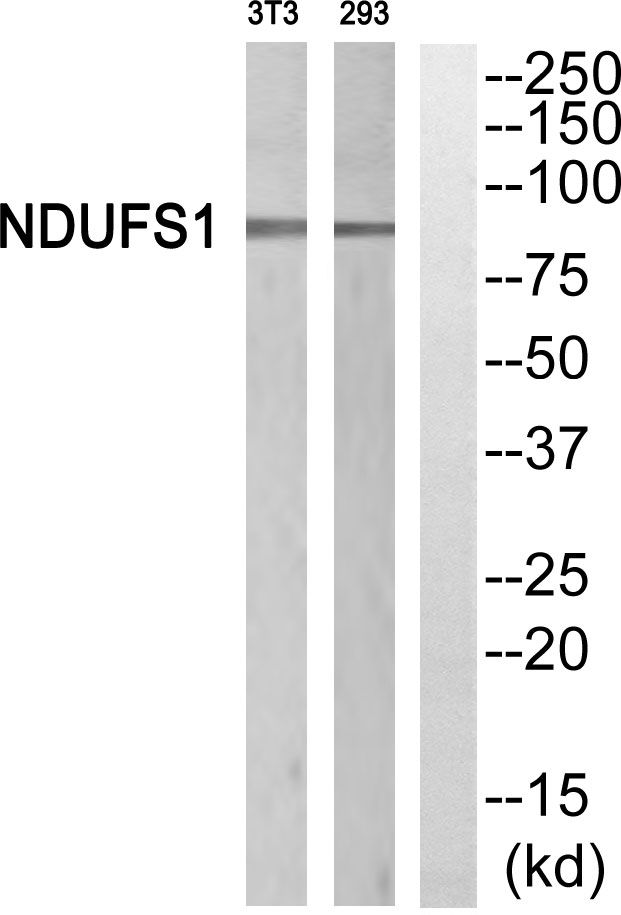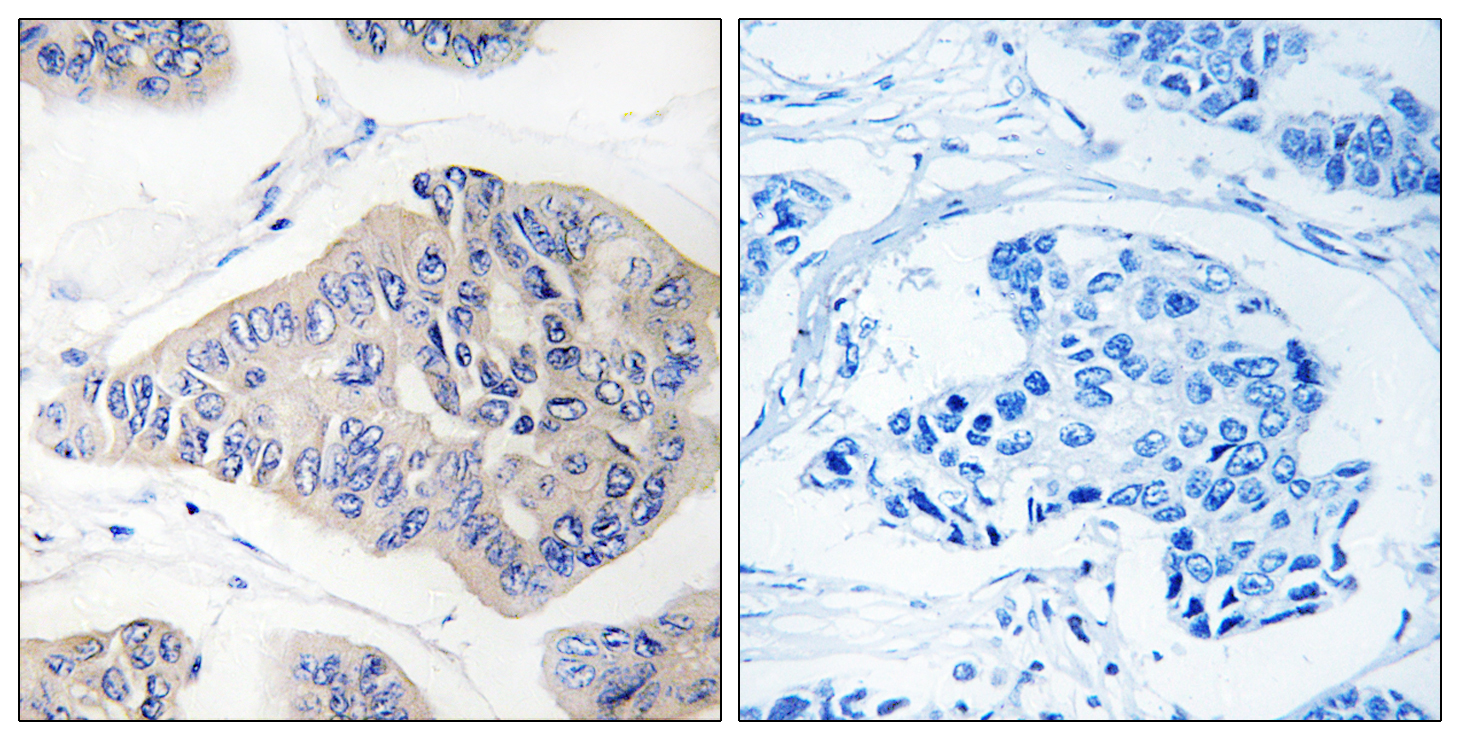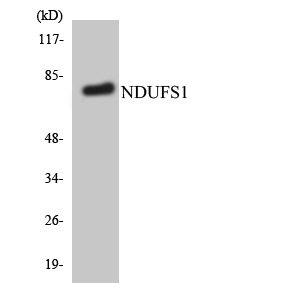NDUFS1 Polyclonal Antibody
- Catalog No.:YT3017
- Applications:WB;IHC;IF;ELISA
- Reactivity:Human;Mouse;Rat
- Target:
- NDUFS1
- Fields:
- >>Oxidative phosphorylation;>>Metabolic pathways;>>Thermogenesis;>>Retrograde endocannabinoid signaling;>>Non-alcoholic fatty liver disease;>>Alzheimer disease;>>Parkinson disease;>>Amyotrophic lateral sclerosis;>>Huntington disease;>>Prion disease;>>Pathways of neurodegeneration - multiple diseases;>>Chemical carcinogenesis - reactive oxygen species;>>Diabetic cardiomyopathy
- Gene Name:
- NDUFS1
- Protein Name:
- NADH-ubiquinone oxidoreductase 75 kDa subunit mitochondrial
- Human Gene Id:
- 4719
- Human Swiss Prot No:
- P28331
- Mouse Gene Id:
- 227197
- Mouse Swiss Prot No:
- Q91VD9
- Rat Gene Id:
- 301458
- Rat Swiss Prot No:
- Q66HF1
- Immunogen:
- The antiserum was produced against synthesized peptide derived from human NDUFS1. AA range:620-669
- Specificity:
- NDUFS1 Polyclonal Antibody detects endogenous levels of NDUFS1 protein.
- Formulation:
- Liquid in PBS containing 50% glycerol, 0.5% BSA and 0.02% sodium azide.
- Source:
- Polyclonal, Rabbit,IgG
- Dilution:
- WB 1:500 - 1:2000. IHC 1:100 - 1:300. ELISA: 1:40000.. IF 1:50-200
- Purification:
- The antibody was affinity-purified from rabbit antiserum by affinity-chromatography using epitope-specific immunogen.
- Concentration:
- 1 mg/ml
- Storage Stability:
- -15°C to -25°C/1 year(Do not lower than -25°C)
- Other Name:
- NDUFS1;NADH-ubiquinone oxidoreductase 75 kDa subunit; mitochondrial;Complex I-75kD;CI-75kD
- Observed Band(KD):
- 80kD
- Background:
- The protein encoded by this gene belongs to the complex I 75 kDa subunit family. Mammalian complex I is composed of 45 different subunits. It locates at the mitochondrial inner membrane. This protein has NADH dehydrogenase activity and oxidoreductase activity. It transfers electrons from NADH to the respiratory chain. The immediate electron acceptor for the enzyme is believed to be ubiquinone. This protein is the largest subunit of complex I and it is a component of the iron-sulfur (IP) fragment of the enzyme. It may form part of the active site crevice where NADH is oxidized. Mutations in this gene are associated with complex I deficiency. Several transcript variants encoding different isoforms have been found for this gene. [provided by RefSeq, Jan 2011],
- Function:
- catalytic activity:NADH + acceptor = NAD(+) + reduced acceptor.,catalytic activity:NADH + ubiquinone = NAD(+) + ubiquinol.,cofactor:Binds 1 2Fe-2S cluster per subunit.,cofactor:Binds 2 4Fe-4S clusters per subunit.,disease:Defects in NDUFS1 are a cause of complex I mitochondrial respiratory chain deficiency [MIM:252010]. Complex I (NADH-ubiquinone oxidoreductase), the largest complex of the mitochondrial respiratory chain, contains more than 40 subunits. It is embedded in the inner mitochondrial membrane and is partly protruding in the matrix. Complex I deficiency is the most common cause of mitochondrial disorders. It represents largely one-third of all cases of respiratory chain deficiency and is responsible for a variety of clinical symptoms, ranging from neurological disorders to cardiomyopathy, liver failure, and myopathy.,function:Core subunit of the mitochondrial membrane respirato
- Subcellular Location:
- Mitochondrion inner membrane ; Peripheral membrane protein ; Matrix side .
- Expression:
- Brain,Cajal-Retzius cell,Colon,Fetal brain cortex,Liver,
- June 19-2018
- WESTERN IMMUNOBLOTTING PROTOCOL
- June 19-2018
- IMMUNOHISTOCHEMISTRY-PARAFFIN PROTOCOL
- June 19-2018
- IMMUNOFLUORESCENCE PROTOCOL
- September 08-2020
- FLOW-CYTOMEYRT-PROTOCOL
- May 20-2022
- Cell-Based ELISA│解您多样本WB检测之困扰
- July 13-2018
- CELL-BASED-ELISA-PROTOCOL-FOR-ACETYL-PROTEIN
- July 13-2018
- CELL-BASED-ELISA-PROTOCOL-FOR-PHOSPHO-PROTEIN
- July 13-2018
- Antibody-FAQs
- Products Images

- Western blot analysis of NDUFS1 Antibody. The lane on the right is blocked with the NDUFS1 peptide.

- Immunohistochemistryt analysis of paraffin-embedded human breast carcinoma, using NDUFS1 Antibody. The lane on the right is blocked with the NDUFS1 peptide.

- Western blot analysis of the lysates from HepG2 cells using NDUFS1 antibody.



